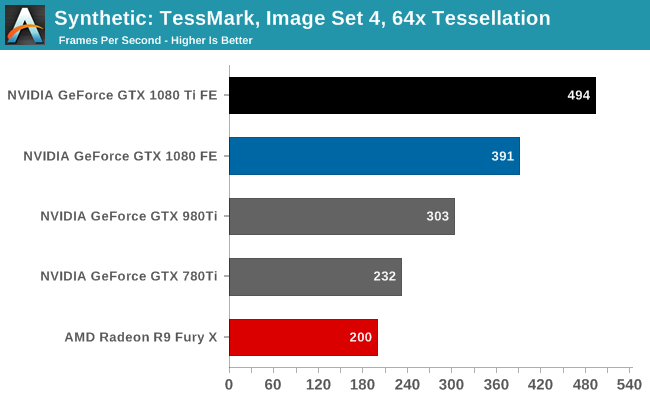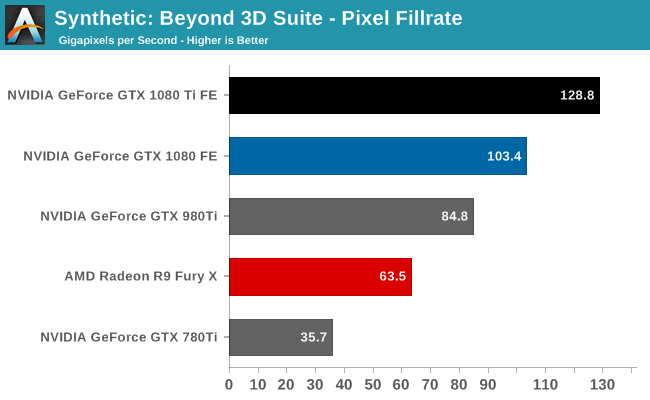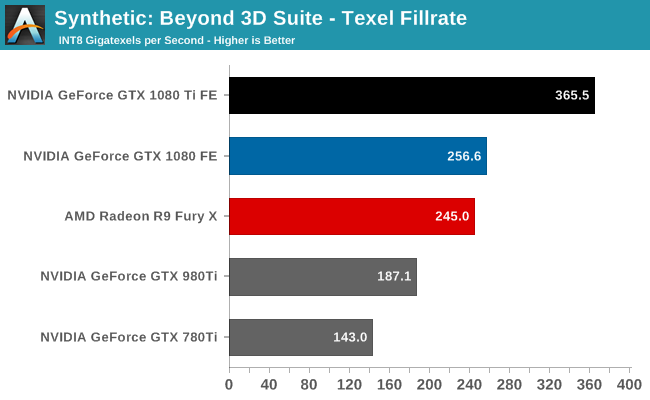The NVIDIA GeForce GTX 1080 Ti Founder's Edition Review: Bigger Pascal for Better Performance
by Ryan Smith on March 9, 2017 9:00 AM ESTSynthetics
As always we’ll also take a quick look at synthetic performance. As a pretty straightforward and wider implementation of Pascal, GTX 1080 Ti shouldn't offer too many surprises here.

With TessMark, we find that the that the GTX 1080 Ti offers 26% better tessellation performance than the GTX 1080, and 63% better performance than the GTX 980 Ti. NVIDIA has always built their architectures geometry-heavy, and GTX 1080 Ti further adds to that lead.
Finally, for looking at texel and pixel fillrate, we have the Beyond3D Test Suite. This test offers a slew of additional tests – many of which use behind the scenes or in our earlier architectural analysis – but for now we’ll stick to simple pixel and texel fillrates.


As it turns out, the pixel fillrate results for the GTX 1080 Ti are a bit surprising. The GTX 1080 Ti doesn’t dominate by as much as I would have expected given the massive memory bandwidth advantage and additional ROP throughput. Not that a 25% increase over the GTX 1080 is anything to sneeze at, but I wonder if we’re looking at one of the consequences of the unusual way NVIDIA has cut-down GP102 for GTX 1080 Ti. We haven’t seen NVIDIA disable a single ROP/memory channel at the high-end before in this manner.
As for texel fillrate, the GTX 1080 Ti excels. In fact it does a bit better than I’d otherwise expect based on the specifications. This could be a sign that GTX 1080 is a bit bandwidth limited at times when it comes to texel throughput, as that’s the facet of performance the GTX 1080 Ti has improved upon the most.










161 Comments
View All Comments
ryvoth - Thursday, March 9, 2017 - link
Solid card release from NVIDIA too bad our costs in Canada suck due to the dollar.mapesdhs - Saturday, March 11, 2017 - link
Ditto the UK. Sites keep mentioning an RRP of $700, but in the UK it's the equivalent of more like $900+.Meteor2 - Tuesday, March 14, 2017 - link
Don't forget the US doesn't have VAT. Or a NHS.Mr Perfect - Thursday, March 9, 2017 - link
Wait, so Pascal is going to have a two year lifecycle as-is? There won't be a refinement cycle like Fermi to Kepler? That's a little disappointing.Ryan Smith - Thursday, March 9, 2017 - link
Fermi technically had a 2-year lifecycle. The only reason it was special is because the original silicon had issues, and NV opted to fix it.There are still yearly product refreshes, but GPUs are too expensive to develop (and the underlying manufacturing process too slow to advance) to do top-to-bottom new GPUs every single year.
supcaj - Thursday, March 9, 2017 - link
Disappointed to STILL not see ANY VR-related benchmarks in the suite. VR rendering has unique rendering requirements, and a huge margin of gamers have moved or are planning to move to VR during the lifetime of this card.r3loaded - Thursday, March 9, 2017 - link
Hey, 'member when top-tier GPUs costed $499? I 'member!eddman - Thursday, March 9, 2017 - link
http://i.imgur.com/pGKlskP.pngMr Perfect - Thursday, March 9, 2017 - link
I'd love to see how that compares father back, adjusted for inflation. My rose tinted goggles have me remembering top-tier GPUs launching for $400 or less back in the early 2000s, but who knows how that compares to 2017 dollars.eddman - Friday, March 10, 2017 - link
http://i.imgur.com/OU6612c.pngThere are a lot of inflation calculators online. Like this: https://www.bls.gov/data/inflation_calculator.htm
A geforce 2 ultra was $705 in 2017 dollars!